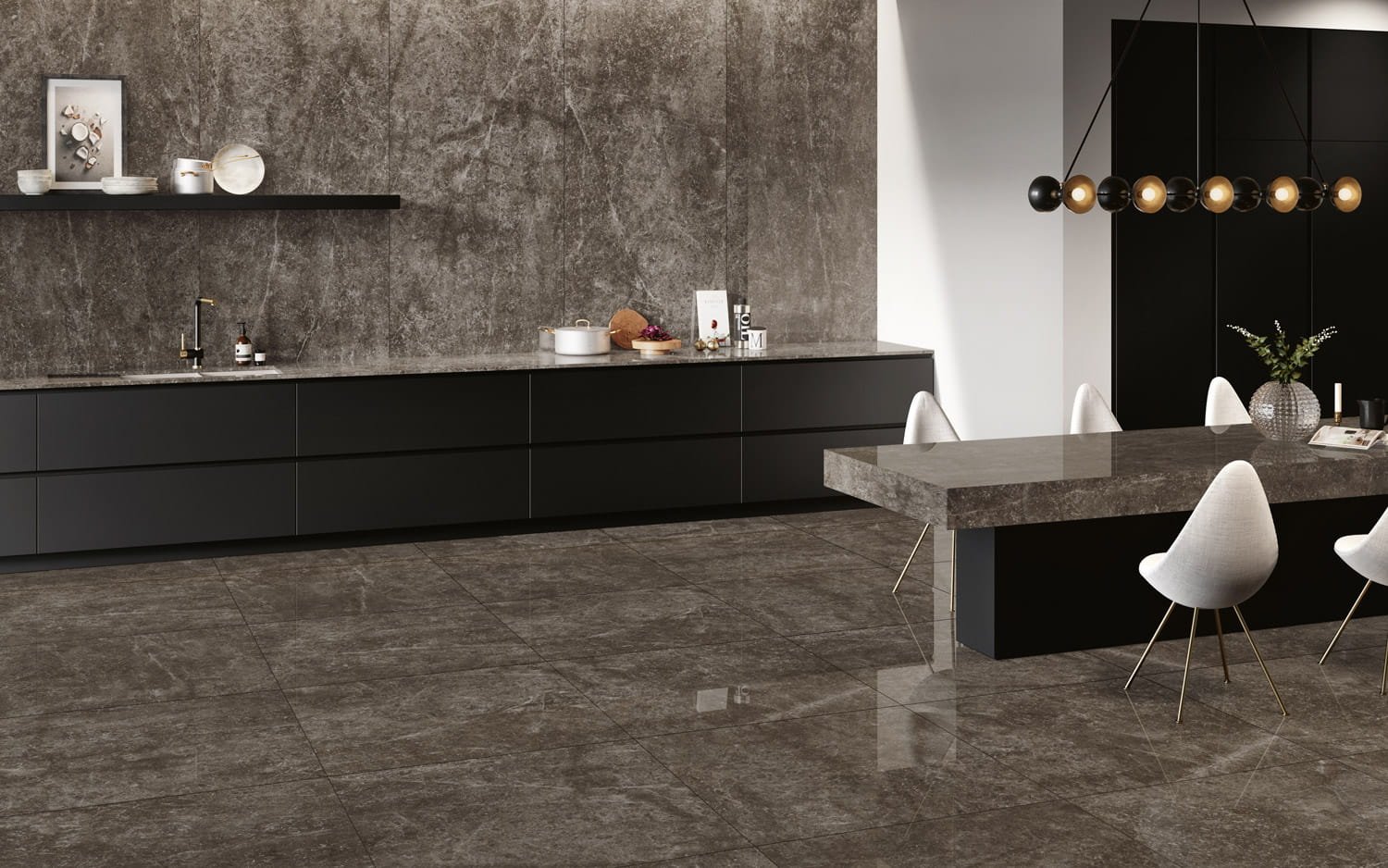Currently, the industry produces a large amount of finishing materials for internal and external use. In this article, we will consider what are the types of ceramic tiles and for what purposes their use is recommended.

Type of manufacture of ceramic tiles
The main classification of finishing ceramics is based on the method of its production:
made of a mixture of clays by double firing. The raw material is pressed and sintered in a semi-finished product at a temperature of about 1000 ° C. On this base, a decorative finishing layer is applied, which is fixed by repeated firing. Due to the double heat treatment, the enamel and the biscuit have a relatively low adhesive strength, so used exclusively for the decoration of internal walls.
Vitrified tiles is made from different types of clay. The raw material is pressed, the powder enamel is applied and burned at a temperature of around 1200 ° C. The resulting product has a high adhesion of enamel and biscuit, therefore, it is used for the installation of floor and wall coverings environments. This technology is also used to produce products for facade work. The “Vitrified” class includes a porous type of tile.
non-glazed material made by extrusion (extrusion by slotted mold) and sintered once. The result is a high-strength porous tile used for floors; Clinker is a highly resistant finishing material obtained by a single burning of pressed or extruded parts. It is used for exterior facade work, pool finishing, floor covering. In some cases, the clinker is enameled and covered with a glassy mass (“salt”).
Porcelain stoneware is the most durable finishing material obtained by pressing a slip under high pressure (about 50 MPa) followed by single sintering at temperatures of around 1300 ° C. The products are distinguished by versatility, even in environments with high loads.
Surface Type of ceramic tiles
Depending on the production method, the following types of ceramic tile surfaces are distinguished:
– enameled: an enamel is applied over the biscuit, which makes the product shiny and decorative
– without enamel: porcelain stoneware, clinker, Cotto
– glazed mate: not processed after firing
– polished: the top layer is removed to obtain a smooth and shiny surface (porcelain stoneware, Cotto)
– semi-polished (polished glazed porcelain tiles): the top layer is partially removed to obtain combined polished and unpolished areas (porcelain stoneware)
– emi-matte (satin) (porcelain stoneware)
– with a thin glass layer (porcelain stoneware, clinker)

Quality rating of ceramic tiles
According to the quality of the finish, the tile is divided into varieties:
1st degree: on the packaging no more than 5% of tiles with deviations in the aesthetic indicators, determined in an arrangement of 30 or more tiles at a distance of 1 m under 300 lux lighting. The functional criteria (dimensions and characteristics) must meet the UNI requirements. The first-grade tiles are marked in red;
Grade 2: on the packaging no more than 5% of tiles with deviations in the aesthetic indicators, determined in an arrangement of 30 or more tiles at a distance of 2 m under 300 lux lighting. Size deviations must not exceed 25% of the characteristics of the 1st degree. Physico-chemical properties are specified in UNI standards. The first-grade tiles are marked in blue;
Grade 3 – material that does not meet the first two grades. Third-grade tiles are marked in green;
The commercial classification is marked in black and meets the minimum product requirements of 3 classifications.
When choosing a piece, consider its caliber. When releasing elements of a certain size, the manufacturer cannot guarantee their exact match. This is due to the firing technology, after which excess moisture is removed from the starting material. As a result, the tile size is reduced. In addition, the variances vary from batch to batch. That is why the tiles are placed with cracks (seams). Perfect installation is only allowed for rectified porcelain stoneware, which is trimmed after production. The production size of the product is called caliber, which is indicated on the packaging. The maximum deviation from the nominal value must not exceed 2% (up to 5 mm).
Due to the peculiarities of production, the finishing ceramics differ in color (tone). Therefore, for repairs, it is recommended to order the entire batch of tiles with a margin to trim immediately.
Wear resistance
The tile’s resistance to abrasion influences determines the scope of its application. For apartments and private houses, it is more efficient to use cheaper materials with low surface resistance, as they do not suffer significant loads during operation. For the decoration of shopping centers, large stores, other places with a large flow of visitors and the movement of machines, it is recommended to use more expensive products with greater resistance to wear. According to this criterion, the blocks of the following categories are distinguished:
PEI I: category of tiles with low wear resistance, suitable for finishing domestic bathrooms, kitchens, bathrooms;
PEI II: category of tiles with moderate wear resistance. Suitable for installation in a private corridor, corridor, living room;
PEI III: product category with medium wear resistance adapted for residential and office floor coverings;
PEI IV: category of materials with high wear resistance. It is used for finishing, food establishments, hotels, and other objects with increased load on the coating;
PEI V: product category with the highest wear resistance for particularly severe operating conditions.
Porosity and water absorption
In the production of ceramic finishing materials, different starting materials are used, schemes for molding products, and their firing. Therefore, one of the main technological properties of the finished product is considered to be porosity (presence of voids in the body of cooked pieces or porcelain stoneware).

There are two types of porosity:
open: the pores exit to the product surface
closed: the pores are located inside the tile.
The water absorption indicator of the material (ability to absorb a certain amount of moisture) depends on the porosity. According to this indicator, the following types of ceramic tiles are distinguished:
– with minimum water absorption of less than 3% (porcelain stoneware, clinker)
– using with average water absorption of 3 to 6% (porcelain stoneware, clinker)
– work with average water absorption of 6 to 10% (monocot)
– with 10% high water absorption (bicottura, monoporous, majolica, earthenware).
– Water absorption is also classified according to the product’s molding technology
Friction coefficient
For floors, the coefficient of friction of the material is of particular importance, which determines the safety of using floors in domestic and industrial conditions. For example, in the bathroom, pool, balcony, tiles must be used
Alternative coatings:
– Consider some other materials you can choose for walls, floors, and facades
– paints and varnishes are easier to use, but not suitable for damp rooms as well as floors
– Self-leveling floors are easy to apply, have high resistance to humidity, do not require professional installation skills, but are inferior to ceramics in terms of decorative characteristics
– wallpaper is used to decorate walls and an alternative can be considered with great assumptions
– plaster mixes are suitable for facing walls and façades but differ in application hardship and low resistance to aggressive factors
– mosaic plaster with quartz aggregate is suitable for facade work and is rarely used in interiors
– the glass mosaic can be used to decorate walls, columns, and other non-flat elements inside and outside the premises
– The plastic and metal coating is installed to protect facades and is considered a good alternative for finishing commercial and private objects
– laminate, linoleum, parquet board, natural parquet, and other floor materials are widely used to decorate environments with low humidity.





